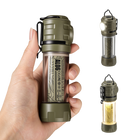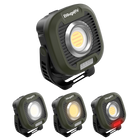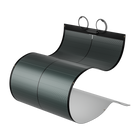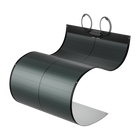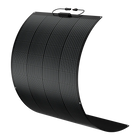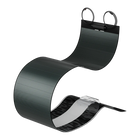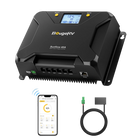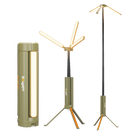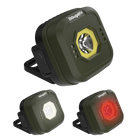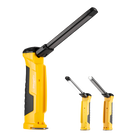Can I Mix 100 Watt and 200 Watt Solar Panels?


Diving into solar power raises many questions, especially when selecting suitable solar panels. One common query is: Can you mix and match 100-watt and 200-watt solar panels? This article addresses this question, providing a clear comparison between 100W and 200W solar panels and guidance on how to seamlessly integrate panels of different wattages, such as mixing 100W and 200W solar panels.
Whether you're just starting with solar or aiming to upgrade your existing system, this blog illuminates the path to optimizing your use of renewable energy.
Explore with us now!
What Is the Difference Between 100W and 200W Solar Panels?
The primary differences between 100W and 200W solar panels lie in their size, power output, weight, and charging capability. A 200W panel, being larger, generates more electricity due to more solar cells and charges batteries more quickly than its 100W counterpart, which is smaller, lighter, and produces less energy.
Can I Mix Different Wattage Solar Panels?

You can certainly mix solar panels with different wattages, such as 100W and 200W, in your solar energy setup. It's crucial to match their nominal voltage(often 12V or 24V) for both series and parallel connections to ensure they work together effectively.
To optimize performance, consider grouping solar panels with similar characteristics under the same Maximum Power Point Tracking (MPPT) charge controllers. This approach enables each group of solar panels to operate at its optimal power point, enhancing overall energy yield.
Keep in mind that integrating solar panels of varying wattages and types can add complexity to your system management. It’s advisable to consult with a solar expert who can help design your solar array for peak efficiency, ensuring that all aspects of safety, code compliance, and warranty considerations are addressed.
Mix Different Wattage Solar Panels in Series

When mixing solar panels of different wattages in series, it's vital to examine their electrical specifications closely. Pay particular attention to each panel's Maximum Power Point Voltage (Vmpp). Similar Vmpp values across the panels are essential to prevent the lower-wattage panel from diminishing the total power output of the series string.
Also, keep a close watch on the Open-Circuit Voltage (Voc) of each panel. When you connect panels in series, their Voc values sum up. Make sure that the total Voc does not exceed the maximum input voltage rating of your inverter or charge controller to avoid exposing your system to high voltage levels that could cause damage.
To wire solar panels in series:
-
Link the positive terminal of one panel to the negative terminal of the subsequent panel.
-
Continue this pattern for each panel in the series.
-
The remaining open positive and negative terminals will then connect to the system's charge controller or inverter.
If you’re not certain how to connect them, this BougeRV post about solar panels connection series vs. parallel can be useful!
Advantages of series connection:
-
Wiring solar panels in series sums their voltages, allowing for consistent current and using thinner, less expensive wires, cutting down on your costs and minimizing electrical loss.
-
This configuration suits systems with high-voltage inverters well and is ideal for maximizing energy generation in areas where space is limited.
-
Series connections are simpler to set up, requiring fewer combiner boxes and breakers, which streamlines your solar array's design and can promote its overall reliability and efficiency.
Disadvantages of series connection:
-
A significant drawback is that any mismatch in electrical characteristics will lead to the entire string performing only as well as the lowest wattage panel, which can result in reduced efficiency and power output.
-
Issues such as shading, dirt accumulation, or malfunctions on a single panel can significantly impact the performance of all solar panels in the series.
-
Higher system voltages in series connections may also raise the risk of potential-induced degradation (PID), which can affect system longevity and performance.
Mix Different Wattage Solar Panels in Parallel

In a parallel setup, the focus shifts to the Short-Circuit Current (Isc) values, which should be closely matched to prevent imbalanced current flow that could potentially cause efficiency losses and overload the system.
It's also important to monitor the total current to avoid exceeding the charge controller or inverter's maximum current specifications. By doing so, you can protect your equipment and maintain optimal operation.
To connect solar panels in parallel:
To connect 100W and 200W solar panels in parallel, join the positive terminals together, and do the same with the negative terminals.
In a parallel connection, the currents (amps) from each panel add up while the voltage remains constant.
Advantages of parallel connection:
-
Connecting different wattage solar panels in parallel has advantages for flexible solar installations. This setup allows for system expansion with available panels, regardless of their wattage.
-
It's also beneficial when space constraints require using panels of varying sizes to optimize roof or land usage. Parallel connections help maintain the system voltage, ensuring compatibility with existing inverters and charge controllers.
-
If one panel is shaded or underperforming, it won’t drastically affect the entire system, offering a more reliable energy generation method. With proper management, such as MPPT technology, each panel can contribute effectively, leveraging diverse panel investments for a customized solar array.
Disadvantages of parallel connection:
-
Mixing different wattage solar panels in parallel can reduce system efficiency, as the setup will only produce as much power as the lowest wattage panel allows. This could lead to potential energy waste, especially if lower-output ones constrain higher-wattage panels.
-
Parallel setups with higher currents need thicker cables to handle the added load, which may increase installation costs.
-
The need for multiple advanced charge controllers, microinverters, or blocking diodes may arise to address back-feeding concerns, adding complexity and expense to the system.
Wire Solar Panels in Series-Parallel Connection
Combining series and parallel wiring of solar panels can help maximize the benefits while minimizing the drawbacks of each connection type. By grouping equal wattage panels in series to create strings, and then wiring those strings in parallel, voltage levels and current flows can be managed more effectively.
In any mixed-wiring scenario, it’s crucial to utilize an MPPT (Maximum Power Point Tracking) charge controller or technology. This ensures that the varying outputs from each string are optimized for consistent charging and protect your batteries from overcharging. Alternatively, microinverters can be installed on each solar panel to individually optimize output, preventing power loss due to shading on any panel.
While it is feasible to mix solar panels of different wattages, such setups often involve trade-offs and may require additional components or complex designs to achieve efficient operation. Ideally, solar installations typically use solar panels with matching electrical characteristics to simplify system design and enhance energy harvest efficiency.
Mix and Match Solar Panels With Microinverters
Using microinverters in a solar panel array allows for a mix-and-match approach to your solar system. Each panel has its own inverter, which means the conversion from DC (direct current) to AC (alternating current) happens on an individual basis. This enhances the system’s overall efficiency.
Microinverter it's particularly useful in situations where panels are installed in different positions or might be shaded throughout the day. By adding each solar panel with its own microinverter, the performance of one underperforming panel won’t adversely affect the entire array, unlike systems with a central inverter where the weakest panel could reduce the output of all panels connected in series.
While most microinverters are designed for single-panel management, some models can handle multiple panels. With these advantages, microinverters offer an efficient solution for optimizing diverse and potentially complex solar panel configurations.
Final Thoughts
Mixing 100W and 200W solar panels effectively boosts your system's versatility. Utilize MPPT technology and microinverters to optimize efficiency in series and parallel connections. With the right compatibility and design, you can harness solar power to its full potential.
Check out the selection of 12V 100W and 200W solar panels and components at BougeRV.com and elevate your camping, home, or business with sustainable energy solutions!
FAQs
1. Does Connecting Solar Panels in Parallel Increase Wattage?
Wiring solar panels in parallel boosts the system's total wattage by adding up the individual solar panel outputs while maintaining a consistent voltage, effectively increasing the available power for your home or business without altering the voltage output of each panel.
2. Will I Damage My Solar Panels if I Mix 100-watt and 200-watt Panels?
It's unlikely to damage your solar panels when proper electrical matching and system design are followed. By arranging correctly with appropriate charge controllers and electrical protections, you can prevent damage and safely combine 100W and 200W solar panels into a single solar array.
3. Can You Mix Different Brands of Solar Panels?
Yes, you can mix different brands of solar panels as long as they have similar specifications and quality standards. For optimal system performance and safety, you should consider compatibility in terms of voltage, current, wattage, efficiency, size, or warranty. And ensure the solar panels are compatible with your inverter or microinverters.
4. Can I Connect 2 Inverters to the Same Solar Panel?
It’s uncommon and not recommended to connect two inverters to the same solar panel due to the risk of inefficiencies or damage. However, there are scenarios where this may be feasible with certain types of inverters, but it requires specialized equipment and careful configuration.
5. Can I Mix Microinverters?
You can mix microinverters from different brands or models, as long as they are compatible with each other and with your solar panels.
However, we don’t recommend this practice because mixing different types of microinverters may lead to compatibility issues and could potentially void warranty agreements. It's always best to stick to one brand and model for consistency and ease of troubleshooting.
If you need to mix microinverters from different brands or models, you should check the compatibility charts and manuals provided by the manufacturers before buying.
6. How Many Solar Panels Can a Micro Inverter Handle?
A microinverter can handle typically ranges from one to four panels per unit. Most commonly, microinverters are designed for single-panel optimization, providing a one-to-one setup that maximizes output efficiency and simplifies monitoring.
If you have a 250W microinverter and a 200W solar panel, you can only connect one panel to it. If you have a 250w microinverter and a 100w solar panel, you can connect two panels to it.
You can find various models tailored to the panel's wattage, ensuring compatibility and streamlined energy production.








